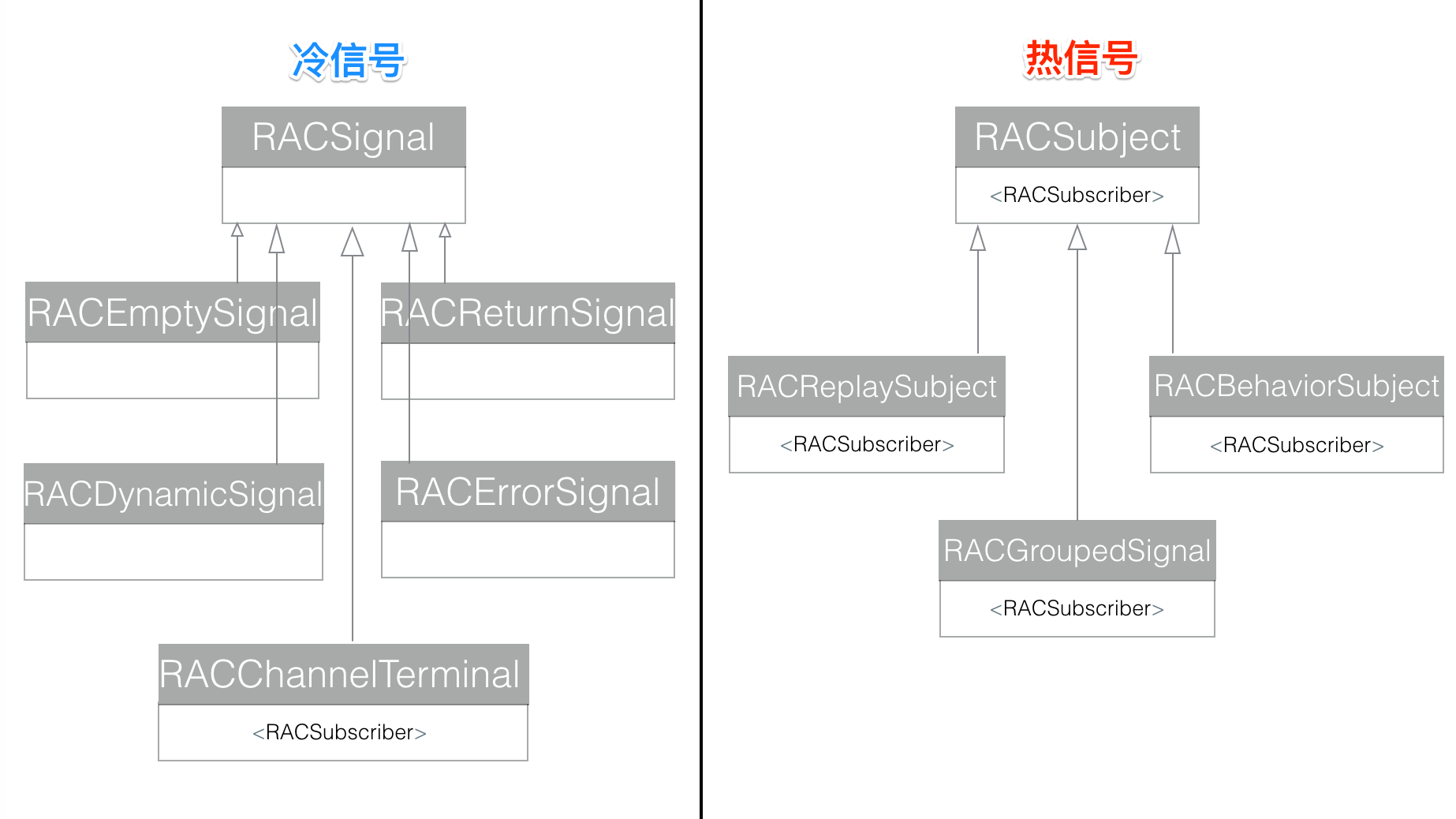前言
关于ReactiveCocoa v2.5中冷信号和热信号的文章中,最著名的就是美团的臧成威老师写的3篇冷热信号的文章:
细说ReactiveCocoa的冷信号与热信号(一)
细说ReactiveCocoa的冷信号与热信号(二):为什么要区分冷热信号
细说ReactiveCocoa的冷信号与热信号(三):怎么处理冷信号与热信号
由于最近在写关于RACSignal底层实现分析的文章,当然也逃不了关于冷热信号操作的分析。这篇文章打算分析分析如何从冷信号转成热信号的底层实现。
目录
- 1.关于冷信号和热信号的概念
- 2.RACSignal热信号
- 3.RACSignal冷信号
- 4.冷信号是如何转换成热信号的
一. 关于冷信号和热信号的概念

冷热信号的概念是源自于源于.NET框架Reactive Extensions(RX)中的Hot Observable和Cold Observable,
Hot Observable是主动的,尽管你并没有订阅事件,但是它会时刻推送,就像鼠标移动;而Cold Observable是被动的,只有当你订阅的时候,它才会发布消息。
Hot Observable可以有多个订阅者,是一对多,集合可以与订阅者共享信息;而Cold Observable只能一对一,当有不同的订阅者,消息是重新完整发送。
在这篇文章细说ReactiveCocoa的冷信号与热信号(一)详细分析了冷热信号的特点:
热信号是主动的,即使你没有订阅事件,它仍然会时刻推送。而冷信号是被动的,只有当你订阅的时候,它才会发送消息。
热信号可以有多个订阅者,是一对多,信号可以与订阅者共享信息。而冷信号只能一对一,当有不同的订阅者,消息会从新完整发送。
二. RACSignal热信号

RACSignal家族中符合热信号的特点的信号有以下几个。
1.RACSubject
@interface RACSubject : RACSignal <RACSubscriber>
@property (nonatomic, strong, readonly) NSMutableArray *subscribers;
@property (nonatomic, strong, readonly) RACCompoundDisposable *disposable;
- (void)enumerateSubscribersUsingBlock:(void (^)(id<RACSubscriber> subscriber))block;
+ (instancetype)subject;
@end
首先来看看RACSubject的定义。
RACSubject是继承自RACSignal,并且它还遵守RACSubscriber协议。这就意味着它既能订阅信号,也能发送信号。
在RACSubject里面有一个NSMutableArray数组,里面装着该信号的所有订阅者。其次还有一个RACCompoundDisposable信号,里面装着该信号所有订阅者的RACDisposable。
RACSubject之所以能称之为热信号,那么它肯定是符合上述热信号的定义的。让我们从它的实现来看看它是如何符合的。
- (RACDisposable *)subscribe:(id<RACSubscriber>)subscriber {
NSCParameterAssert(subscriber != nil);
RACCompoundDisposable *disposable = [RACCompoundDisposable compoundDisposable];
subscriber = [[RACPassthroughSubscriber alloc] initWithSubscriber:subscriber signal:self disposable:disposable];
NSMutableArray *subscribers = self.subscribers;
@synchronized (subscribers) {
[subscribers addObject:subscriber];
}
return [RACDisposable disposableWithBlock:^{
@synchronized (subscribers) {
NSUInteger index = [subscribers indexOfObjectWithOptions:NSEnumerationReverse passingTest:^ BOOL (id<RACSubscriber> obj, NSUInteger index, BOOL *stop) {
return obj == subscriber;
}];
if (index != NSNotFound) [subscribers removeObjectAtIndex:index];
}
}];
}
上面是RACSubject的实现,它和RACSignal最大的不同在这两行
NSMutableArray *subscribers = self.subscribers;
@synchronized (subscribers) {
[subscribers addObject:subscriber];
}
RACSubject 把它的所有订阅者全部都保存到了NSMutableArray的数组里。既然保存了所有的订阅者,那么sendNext,sendError,sendCompleted就需要发生改变。
- (void)sendNext:(id)value {
[self enumerateSubscribersUsingBlock:^(id<RACSubscriber> subscriber) {
[subscriber sendNext:value];
}];
}
- (void)sendError:(NSError *)error {
[self.disposable dispose];
[self enumerateSubscribersUsingBlock:^(id<RACSubscriber> subscriber) {
[subscriber sendError:error];
}];
}
- (void)sendCompleted {
[self.disposable dispose];
[self enumerateSubscribersUsingBlock:^(id<RACSubscriber> subscriber) {
[subscriber sendCompleted];
}];
}
从源码可以看到,RACSubject中的sendNext,sendError,sendCompleted都会执行enumerateSubscribersUsingBlock:方法。
- (void)enumerateSubscribersUsingBlock:(void (^)(id<RACSubscriber> subscriber))block {
NSArray *subscribers;
@synchronized (self.subscribers) {
subscribers = [self.subscribers copy];
}
for (id<RACSubscriber> subscriber in subscribers) {
block(subscriber);
}
}
enumerateSubscribersUsingBlock:方法会取出所有RACSubject的订阅者,依次调用入参的block( )方法。
关于RACSubject的订阅和发送的流程可以参考第一篇文章,大体一致,其他的不同就是会依次对自己的订阅者发送信号。
RACSubject就满足了热信号的特点,它即使没有订阅者,因为自己继承了RACSubscriber协议,所以自己本身就可以发送信号。冷信号只能被订阅了才能发送信号。
RACSubject可以有很多订阅者,它也会把这些订阅者都保存到自己的数组里。RACSubject之后再发送信号,订阅者就如同一起看电视,播放过的节目就看不到了,发送过的信号也接收不到了。接收信号。而RACSignal发送信号,订阅者接收信号都只能从头开始接受,如同看点播节目,每次看都从头开始看。
2. RACGroupedSignal
@interface RACGroupedSignal : RACSubject
@property (nonatomic, readonly, copy) id<NSCopying> key;
+ (instancetype)signalWithKey:(id<NSCopying>)key;
@end
先看看RACGroupedSignal的定义。
RACGroupedSignal是在RACsignal这个方法里面被用到的。
- (RACSignal *)groupBy:(id<NSCopying> (^)(id object))keyBlock transform:(id (^)(id object))transformBlock
在这个方法里面,sendNext里面最后里面是由RACGroupedSignal发送信号。
[groupSubject sendNext:transformBlock != NULL ? transformBlock(x) : x];
关于groupBy的详细分析请看这篇文章
3. RACBehaviorSubject
@interface RACBehaviorSubject : RACSubject
@property (nonatomic, strong) id currentValue;
+ (instancetype)behaviorSubjectWithDefaultValue:(id)value;
@end
这个信号里面存储了一个对象currentValue,这里存储着这个信号的最新的值。
当然也可以调用类方法behaviorSubjectWithDefaultValue
+ (instancetype)behaviorSubjectWithDefaultValue:(id)value {
RACBehaviorSubject *subject = [self subject];
subject.currentValue = value;
return subject;
}
在这个方法里面存储默认的值,如果RACBehaviorSubject没有接受到任何值,那么这个信号就会发送这个默认的值。
当RACBehaviorSubject被订阅:
- (RACDisposable *)subscribe:(id<RACSubscriber>)subscriber {
RACDisposable *subscriptionDisposable = [super subscribe:subscriber];
RACDisposable *schedulingDisposable = [RACScheduler.subscriptionScheduler schedule:^{
@synchronized (self) {
[subscriber sendNext:self.currentValue];
}
}];
return [RACDisposable disposableWithBlock:^{
[subscriptionDisposable dispose];
[schedulingDisposable dispose];
}];
}
sendNext里面会始终发送存储的currentValue值。调用sendNext会调用RACSubject里面的sendNext,也会依次发送信号值给订阅数组里面每个订阅者。
当RACBehaviorSubject向订阅者sendNext的时候:
- (void)sendNext:(id)value {
@synchronized (self) {
self.currentValue = value;
[super sendNext:value];
}
}
RACBehaviorSubject会把发送的值更新到currentValue里面。下次发送值就会发送最后更新的值。
4. RACReplaySubject
const NSUInteger RACReplaySubjectUnlimitedCapacity = NSUIntegerMax;
@interface RACReplaySubject : RACSubject
@property (nonatomic, assign, readonly) NSUInteger capacity;
@property (nonatomic, strong, readonly) NSMutableArray *valuesReceived;
@property (nonatomic, assign) BOOL hasCompleted;
@property (nonatomic, assign) BOOL hasError;
@property (nonatomic, strong) NSError *error;
+ (instancetype)replaySubjectWithCapacity:(NSUInteger)capacity;
@end
RACReplaySubject中会存储RACReplaySubjectUnlimitedCapacity大小的历史值。
+ (instancetype)replaySubjectWithCapacity:(NSUInteger)capacity {
return [(RACReplaySubject *)[self alloc] initWithCapacity:capacity];
}
- (instancetype)init {
return [self initWithCapacity:RACReplaySubjectUnlimitedCapacity];
}
- (instancetype)initWithCapacity:(NSUInteger)capacity {
self = [super init];
if (self == nil) return nil;
_capacity = capacity;
_valuesReceived = (capacity == RACReplaySubjectUnlimitedCapacity ? [NSMutableArray array] : [NSMutableArray arrayWithCapacity:capacity]);
return self;
}
在RACReplaySubject初始化中会初始化一个capacity大小的数组。
- (RACDisposable *)subscribe:(id<RACSubscriber>)subscriber {
RACCompoundDisposable *compoundDisposable = [RACCompoundDisposable compoundDisposable];
RACDisposable *schedulingDisposable = [RACScheduler.subscriptionScheduler schedule:^{
@synchronized (self) {
for (id value in self.valuesReceived) {
if (compoundDisposable.disposed) return;
[subscriber sendNext:(value == RACTupleNil.tupleNil ? nil : value)];
}
if (compoundDisposable.disposed) return;
if (self.hasCompleted) {
[subscriber sendCompleted];
} else if (self.hasError) {
[subscriber sendError:self.error];
} else {
RACDisposable *subscriptionDisposable = [super subscribe:subscriber];
[compoundDisposable addDisposable:subscriptionDisposable];
}
}
}];
[compoundDisposable addDisposable:schedulingDisposable];
return compoundDisposable;
}
当RACReplaySubject被订阅的时候,会把valuesReceived数组里面的值都发送出去。
- (void)sendNext:(id)value {
@synchronized (self) {
[self.valuesReceived addObject:value ?: RACTupleNil.tupleNil];
[super sendNext:value];
if (self.capacity != RACReplaySubjectUnlimitedCapacity && self.valuesReceived.count > self.capacity) {
[self.valuesReceived removeObjectsInRange:NSMakeRange(0, self.valuesReceived.count - self.capacity)];
}
}
}
在sendNext中,valuesReceived会保存每次接收到的值。调用super的sendNext,会依次把值都发送到每个订阅者中。
这里还会判断数组里面存储了多少个值。如果存储的值的个数大于了capacity,那么要移除掉数组里面从0开始的前几个值,保证数组里面只装capacity个数的值。
RACReplaySubject 和 RACSubject 的区别在于,RACReplaySubject还会把历史的信号值都存储起来发送给订阅者。这一点,RACReplaySubject更像是RACSingnal 和 RACSubject 的合体版。RACSignal是冷信号,一旦被订阅就会向订阅者发送所有的值,这一点RACReplaySubject和RACSignal是一样的。但是RACReplaySubject又有着RACSubject的特性,会把所有的值发送给多个订阅者。当RACReplaySubject发送完之前存储的历史值之后,之后再发送信号的行为就和RACSubject完全一致了。
三. RACSignal冷信号

在ReactiveCocoa v2.5中除了RACsignal信号以外,还有一些特殊的冷信号。
1.RACEmptySignal
@interface RACEmptySignal : RACSignal
+ (RACSignal *)empty;
@end
这个信号只有一个empty方法。
+ (RACSignal *)empty {
#ifdef DEBUG
return [[[self alloc] init] setNameWithFormat:@"+empty"];
#else
static id singleton;
static dispatch_once_t pred;
dispatch_once(&pred, ^{
singleton = [[self alloc] init];
});
return singleton;
#endif
}
在debug模式下,返回一个名字叫empty的信号。在release模式下,返回一个单例的empty信号。
- (RACDisposable *)subscribe:(id<RACSubscriber>)subscriber {
NSCParameterAssert(subscriber != nil);
return [RACScheduler.subscriptionScheduler schedule:^{
[subscriber sendCompleted];
}];
}
RACEmptySignal信号一旦被订阅就会发送sendCompleted。
2. RACReturnSignal
@interface RACReturnSignal : RACSignal
@property (nonatomic, strong, readonly) id value;
+ (RACSignal *)return:(id)value;
@end
RACReturnSignal信号的定义也很简单,直接根据value的值返回一个RACSignal。
+ (RACSignal *)return:(id)value {
#ifndef DEBUG
if (value == RACUnit.defaultUnit) {
static RACReturnSignal *unitSingleton;
static dispatch_once_t unitPred;
dispatch_once(&unitPred, ^{
unitSingleton = [[self alloc] init];
unitSingleton->_value = RACUnit.defaultUnit;
});
return unitSingleton;
} else if (value == nil) {
static RACReturnSignal *nilSingleton;
static dispatch_once_t nilPred;
dispatch_once(&nilPred, ^{
nilSingleton = [[self alloc] init];
nilSingleton->_value = nil;
});
return nilSingleton;
}
#endif
RACReturnSignal *signal = [[self alloc] init];
signal->_value = value;
#ifdef DEBUG
[signal setNameWithFormat:@"+return: %@", value];
#endif
return signal;
}
在debug模式下直接新建一个RACReturnSignal信号里面的值存储的是入参value。在release模式下,会依照value的值是否是空,来新建对应的单例RACReturnSignal。
- (RACDisposable *)subscribe:(id<RACSubscriber>)subscriber {
NSCParameterAssert(subscriber != nil);
return [RACScheduler.subscriptionScheduler schedule:^{
[subscriber sendNext:self.value];
[subscriber sendCompleted];
}];
}
RACReturnSignal在被订阅的时候,就只会发送一个value值的信号,发送完毕之后就sendCompleted。
3. RACDynamicSignal
这个信号是创建RACSignal createSignal:的真身。关于RACDynamicSignal详细过程请看第一篇文章。
4. RACErrorSignal
@interface RACErrorSignal : RACSignal
@property (nonatomic, strong, readonly) NSError *error;
+ (RACSignal *)error:(NSError *)error;
@end
RACErrorSignal信号里面就存储了一个NSError。
+ (RACSignal *)error:(NSError *)error {
RACErrorSignal *signal = [[self alloc] init];
signal->_error = error;
#ifdef DEBUG
[signal setNameWithFormat:@"+error: %@", error];
#else
signal.name = @"+error:";
#endif
return signal;
}
RACErrorSignal初始化的时候把外界传进来的Error保存起来。当被订阅的时候就发送这个Error出去。
5. RACChannelTerminal
@interface RACChannelTerminal : RACSignal <RACSubscriber>
- (id)init __attribute__((unavailable("Instantiate a RACChannel instead")));
@property (nonatomic, strong, readonly) RACSignal *values;
@property (nonatomic, strong, readonly) id<RACSubscriber> otherTerminal;
- (id)initWithValues:(RACSignal *)values otherTerminal:(id<RACSubscriber>)otherTerminal;
@end
RACChannelTerminal在RAC日常开发中,用来双向绑定的。它和RACSubject一样,既继承自RACSignal,同样又遵守RACSubscriber协议。虽然具有RACSubject的发送和接收信号的特性,但是它依旧是冷信号,因为它无法一对多,它发送信号还是只能一对一。
RACChannelTerminal无法手动初始化,需要靠RACChannel去初始化。
- (id)init {
self = [super init];
if (self == nil) return nil;
RACReplaySubject *leadingSubject = [[RACReplaySubject replaySubjectWithCapacity:0] setNameWithFormat:@"leadingSubject"];
RACReplaySubject *followingSubject = [[RACReplaySubject replaySubjectWithCapacity:1] setNameWithFormat:@"followingSubject"];
[[leadingSubject ignoreValues] subscribe:followingSubject];
[[followingSubject ignoreValues] subscribe:leadingSubject];
_leadingTerminal = [[[RACChannelTerminal alloc] initWithValues:leadingSubject otherTerminal:followingSubject] setNameWithFormat:@"leadingTerminal"];
_followingTerminal = [[[RACChannelTerminal alloc] initWithValues:followingSubject otherTerminal:leadingSubject] setNameWithFormat:@"followingTerminal"];
return self;
}
在RACChannel的初始化中会调用RACChannelTerminal的initWithValues:方法,这里的入参都是RACReplaySubject类型的。所以订阅RACChannelTerminal过程的时候:
- (RACDisposable *)subscribe:(id<RACSubscriber>)subscriber {
return [self.values subscribe:subscriber];
}
self.values其实就是一个RACReplaySubject,就相当于订阅RACReplaySubject。订阅过程同上面RACReplaySubject的订阅过程。
- (void)sendNext:(id)value {
[self.otherTerminal sendNext:value];
}
- (void)sendError:(NSError *)error {
[self.otherTerminal sendError:error];
}
- (void)sendCompleted {
[self.otherTerminal sendCompleted];
}
self.otherTerminal也是RACReplaySubject类型的,RACChannelTerminal管道两边都是RACReplaySubject类型的信号。当RACChannelTerminal开始sendNext,sendError,sendCompleted是调用的管道另外一个的RACReplaySubject进行这些对应的操作的。
平时使用RACChannelTerminal的地方在View和ViewModel的双向绑定上面。
例如在登录界面,输入密码文本框TextField和ViewModel的Password双向绑定
RACChannelTerminal *passwordTerminal = [_passwordTextField rac_newTextChannel];
RACChannelTerminal *viewModelPasswordTerminal = RACChannelTo(_viewModel, password);
[viewModelPasswordTerminal subscribe:passwordTerminal];
[passwordTerminal subscribe:viewModelPasswordTerminal];
双向绑定的两个信号都会因为对方的改变而收到新的信号。
至此所有的RACSignal的分类就都理顺了,按照冷信号和热信号的分类也分好了。

四. 冷信号是如何转换成热信号的

为何有时候需要把冷信号转换成热信号呢?详情可以看这篇文章里面举的例子:细说ReactiveCocoa的冷信号与热信号(二):为什么要区分冷热信号
根据RACSignal订阅和发送信号的流程,我们可以知道,每订阅一次冷信号RACSignal,就会执行一次didSubscribe闭包。这个时候就是可能出现问题的地方。如果RACSignal是被用于网络请求,那么在didSubscribe闭包里面会被重复的请求。上面文中提到了信号被订阅了6次,网络请求也会请求6次。这并不是我们想要的。网络请求只需要请求1次。
如何做到信号只执行一次didSubscribe闭包,最重要的一点是RACSignal冷信号只能被订阅一次。由于冷信号只能一对一,那么想一对多就只能交给热信号去处理了。这时候就需要把冷信号转换成热信号。
在ReactiveCocoa v2.5中,冷信号转换成热信号需要用到RACMulticastConnection 这个类。
@interface RACMulticastConnection : NSObject
@property (nonatomic, strong, readonly) RACSignal *signal;
- (RACDisposable *)connect;
- (RACSignal *)autoconnect;
@end
@interface RACMulticastConnection () {
RACSubject *_signal;
int32_t volatile _hasConnected;
}
@property (nonatomic, readonly, strong) RACSignal *sourceSignal;
@property (strong) RACSerialDisposable *serialDisposable;
@end
看看RACMulticastConnection类的定义。最主要的是保存了两个信号,一个是RACSubject,一个是sourceSignal(RACSignal类型)。在.h中暴露给外面的是RACSignal,在.m中实际使用的是RACSubject。看它的定义就能猜到接下去它会做什么:用sourceSignal去发送信号,内部再用RACSubject去订阅sourceSignal,然后RACSubject会把sourceSignal的信号值依次发给它的订阅者们。

用一个不恰当的比喻来形容RACMulticastConnection,它就像上图中心的那个“地球”,“地球”就是订阅了sourceSignal的RACSubject,RACSubject把值发送给各个“连接”者(订阅者)。sourceSignal只有内部的RACSubject一个订阅者,所以就完成了我们只想执行didSubscribe闭包一次,但是能把值发送给各个订阅者的愿望。
在看看RACMulticastConnection的初始化
- (id)initWithSourceSignal:(RACSignal *)source subject:(RACSubject *)subject {
NSCParameterAssert(source != nil);
NSCParameterAssert(subject != nil);
self = [super init];
if (self == nil) return nil;
_sourceSignal = source;
_serialDisposable = [[RACSerialDisposable alloc] init];
_signal = subject;
return self;
}
初始化方法就是把外界传进来的RACSignal保存成sourceSignal,把外界传进来的RACSubject保存成自己的signal属性。
RACMulticastConnection有两个连接方法。
- (RACDisposable *)connect {
BOOL shouldConnect = OSAtomicCompareAndSwap32Barrier(0, 1, &_hasConnected);
if (shouldConnect) {
self.serialDisposable.disposable = [self.sourceSignal subscribe:_signal];
}
return self.serialDisposable;
}
这里出现了一个不多见的函数OSAtomicCompareAndSwap32Barrier,它是原子运算的操作符,主要用于Compare and swap,原型如下:
bool OSAtomicCompareAndSwap32Barrier( int32_t __oldValue, int32_t __newValue, volatile int32_t *__theValue );
关键字volatile只确保每次获取volatile变量时都是从内存加载变量,而不是使用寄存器里面的值,但是它不保证代码访问变量是正确的。
如果用伪代码去实现这个函数:
f (*__theValue == __oldValue) {
*__theValue = __newValue;
return 1;
} else {
return 0;
}
如果_hasConnected为0,意味着没有连接,OSAtomicCompareAndSwap32Barrier返回1,shouldConnect就应该连接。如果_hasConnected为1,意味着已经连接过了,OSAtomicCompareAndSwap32Barrier返回0,shouldConnect不会再次连接。
所谓连接的过程就是RACMulticastConnection内部用RACSubject订阅self.sourceSignal。sourceSignal是RACSignal,会把订阅者RACSubject保存到RACPassthroughSubscriber中,sendNext的时候就会调用RACSubject sendNext,这时就会把sourceSignal的信号都发送给各个订阅者了。
- (RACSignal *)autoconnect {
__block volatile int32_t subscriberCount = 0;
return [[RACSignal
createSignal:^(id<RACSubscriber> subscriber) {
OSAtomicIncrement32Barrier(&subscriberCount);
RACDisposable *subscriptionDisposable = [self.signal subscribe:subscriber];
RACDisposable *connectionDisposable = [self connect];
return [RACDisposable disposableWithBlock:^{
[subscriptionDisposable dispose];
if (OSAtomicDecrement32Barrier(&subscriberCount) == 0) {
[connectionDisposable dispose];
}
}];
}]
setNameWithFormat:@"[%@] -autoconnect", self.signal.name];
}
OSAtomicIncrement32Barrier 和 OSAtomicDecrement32Barrier也是原子运算的操作符,分别是+1和-1操作。在autoconnect为了保证线程安全,用到了一个subscriberCount的类似信号量的volatile变量,保证第一个订阅者能连接上。返回的新的信号的订阅者订阅RACSubject,RACSubject也会去订阅内部的sourceSignal。
把冷信号转换成热信号用以下5种方式,5种方法都会用到RACMulticastConnection。接下来一一分析它们的具体实现。
1. multicast:
- (RACMulticastConnection *)multicast:(RACSubject *)subject {
[subject setNameWithFormat:@"[%@] -multicast: %@", self.name, subject.name];
RACMulticastConnection *connection = [[RACMulticastConnection alloc] initWithSourceSignal:self subject:subject];
return connection;
}
multicast:的操作就是初始化一个RACMulticastConnection对象,SourceSignal是self,内部的RACSubject是入参subject。
RACMulticastConnection *connection = [signal multicast:[RACSubject subject]];
[connection.signal subscribeNext:^(id x) {
NSLog(@"%@",x);
}];
[connection connect];
调用 multicast:把冷信号转换成热信号有一个点不方便的是,需要自己手动connect。注意转换完之后的热信号在RACMulticastConnection的signal属性中,所以需要订阅的是connection.signal。
2. publish
- (RACMulticastConnection *)publish {
RACSubject *subject = [[RACSubject subject] setNameWithFormat:@"[%@] -publish", self.name];
RACMulticastConnection *connection = [self multicast:subject];
return connection;
}
publish方法只不过是去调用了multicast:方法,publish内部会新建好一个RACSubject,并把它当成入参传递给RACMulticastConnection。
RACMulticastConnection *connection = [signal publish];
[connection.signal subscribeNext:^(id x) {
NSLog(@"%@",x);
}];
[connection connect];
同样publish方法也需要手动的调用connect方法。
3. replay
- (RACSignal *)replay {
RACReplaySubject *subject = [[RACReplaySubject subject] setNameWithFormat:@"[%@] -replay", self.name];
RACMulticastConnection *connection = [self multicast:subject];
[connection connect];
return connection.signal;
}
replay方法会把RACReplaySubject当成RACMulticastConnection的RACSubject传递进去,初始化好了RACMulticastConnection,再自动调用connect方法,返回的信号就是转换好的热信号,即RACMulticastConnection里面的RACSubject信号。
这里必须是RACReplaySubject,因为在replay方法里面先connect了。如果用RACSubject,那信号在connect之后就会通过RACSubject把原信号发送给各个订阅者了。用RACReplaySubject把信号保存起来,即使replay方法里面先connect,订阅者后订阅也是可以拿到之前的信号值的。
4. replayLast
- (RACSignal *)replayLast {
RACReplaySubject *subject = [[RACReplaySubject replaySubjectWithCapacity:1] setNameWithFormat:@"[%@] -replayLast", self.name];
RACMulticastConnection *connection = [self multicast:subject];
[connection connect];
return connection.signal;
}
replayLast 和 replay的实现基本一样,唯一的不同就是传入的RACReplaySubject的Capacity是1,意味着只能保存最新的值。所以使用replayLast,订阅之后就只能拿到原信号最新的值。
5. replayLazily
- (RACSignal *)replayLazily {
RACMulticastConnection *connection = [self multicast:[RACReplaySubject subject]];
return [[RACSignal
defer:^{
[connection connect];
return connection.signal;
}]
setNameWithFormat:@"[%@] -replayLazily", self.name];
}
replayLazily 的实现也和 replayLast、replay实现很相似。只不过把connect放到了defer的操作里面去了。
defer操作的实现如下:
+ (RACSignal *)defer:(RACSignal * (^)(void))block {
NSCParameterAssert(block != NULL);
return [[RACSignal createSignal:^(id<RACSubscriber> subscriber) {
return [block() subscribe:subscriber];
}] setNameWithFormat:@"+defer:"];
}
defer 单词的字面意思是延迟的。也和这个函数实现的效果是一致的。只有当defer返回的新信号被订阅的时候,才会执行入参block( )闭包。订阅者会订阅这个block( )闭包的返回值RACSignal。
block( )闭包被延迟创建RACSignal了,这就是defer。如果block( )闭包含有和时间有关的操作,或者副作用,想要延迟执行,就可以用defer。
还有一个类似的操作,then
- (RACSignal *)then:(RACSignal * (^)(void))block {
NSCParameterAssert(block != nil);
return [[[self
ignoreValues]
concat:[RACSignal defer:block]]
setNameWithFormat:@"[%@] -then:", self.name];
}
then的操作也是延迟,只不过它是把block( )闭包延迟到原信号发送complete之后。通过then信号变化得到的新的信号,在原信号发送值的期间的时间内,都不会发送任何值,因为ignoreValues了,一旦原信号sendComplete之后,就紧接着block( )闭包产生的信号。
回到replayLazily操作上来,作用同样是把冷信号转换成热信号,只不过sourceSignal是在返回的新信号第一次被订阅的时候才被订阅。原因就是defer延迟了block( )闭包的执行了。
最后
关于ReactiveCocoa v2.5中,冷信号即使转换成了热信号,热信号在之后的变换中还会在变成冷信号,所以在v2.5的版本中会有很多冷信号转成热信号的操作。在ReactiveCocoa v3.0以后的版本中,新增了热信号变换之后还是热信号的机制,如此以来就方便很多,不需要增加很多不必要的冷信号转成热信号的代码。
关于RACSignal的变换操作还剩下高阶信号操作,下篇接着继续分析。最后请大家多多指教。





